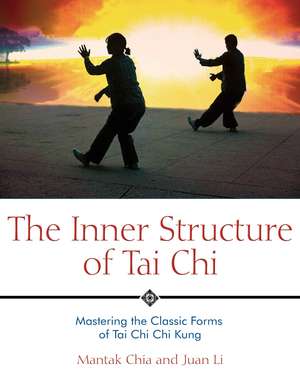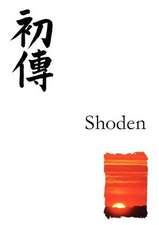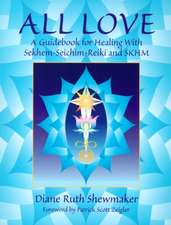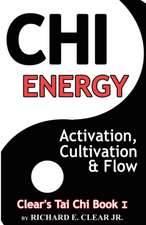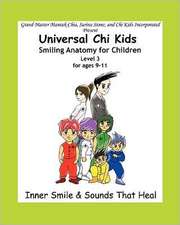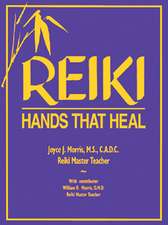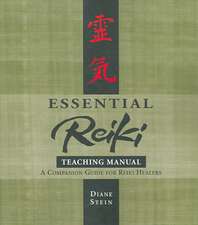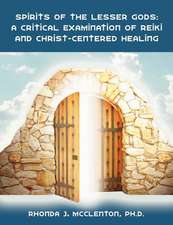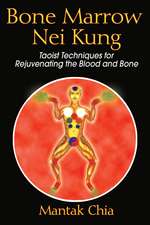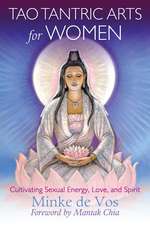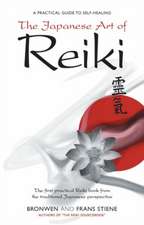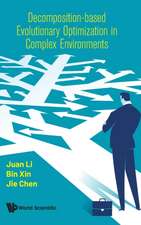The Inner Structure of Tai Chi: Mastering the Classic Forms of Tai Chi Chi Kung
Autor Mantak Chia, Juan Lien Limba Engleză Paperback – 15 dec 2005
Preț: 88.69 lei
Preț vechi: 116.90 lei
-24% Nou
Puncte Express: 133
Preț estimativ în valută:
16.97€ • 17.76$ • 14.10£
16.97€ • 17.76$ • 14.10£
Carte disponibilă
Livrare economică 14-26 martie
Preluare comenzi: 021 569.72.76
Specificații
ISBN-13: 9781594770586
ISBN-10: 1594770581
Pagini: 264
Ilustrații: 245 b&w illustrations
Dimensiuni: 203 x 254 x 20 mm
Greutate: 0.64 kg
Ediția:2nd Edition, New Edition of Inner Structure of Tai Chi
Editura: Inner Traditions/Bear & Company
Colecția Destiny Books
Locul publicării:United States
ISBN-10: 1594770581
Pagini: 264
Ilustrații: 245 b&w illustrations
Dimensiuni: 203 x 254 x 20 mm
Greutate: 0.64 kg
Ediția:2nd Edition, New Edition of Inner Structure of Tai Chi
Editura: Inner Traditions/Bear & Company
Colecția Destiny Books
Locul publicării:United States
Notă biografică
A student of several Taoist masters, Mantak Chia founded the Universal Healing Tao System in 1979 and has taught tens of thousands of students from all over the world. He tours the United States annually, giving workshops and lectures. He is the director of the Tao Garden Health Spa and Resort and the Universal Healing Tao training center in northern Thailand and is the author of 25 books, including the bestselling The Multi-Orgasmic Man. Juan Li is a senior Universal Tao instructor who began his studies with Mantak Chia in 1982 and now presents these teachings throughout Western Europe. He lives in Spain.
Extras
Chapter 3
Basic Principles of Tai Chi Chi Kung
Tai Chi Chi Kung is grounded in the principles of the Tao. The extent to which you have incorporated and integrated these principles into your movements determines your level of mastery. It does not matter if you know a long or a short Tai Chi form; what counts is knowledge and application of the Tai Chi principles.
This chapter introduces the basic principles of Tai Chi Chi Kung. Study them, memorize them, and apply them in your movements. The best way to practice initially is to take one principle at a time and work on it until you can do it automatically, without conscious thought. Then work on the next principle in the same way until you have mastered them all.
The second half of this book introduces the more advanced Tai Chi Chi Kung principles. Do not worry about learning these until you have mastered the more basic principles included in this chapter and have gained competence in the Tai Chi Chi Kung form (or another Tai Chi style) as presented in chapter 5. Eventually, with daily practice, you will discover that you have incorporated the Tai Chi principles into your everyday life--as you sit, walk, stand, and lie down, you will notice that you are moving in a fresh, effortless, and beautiful way. This is the reward of Tai Chi Chi Kung.
Here, then, are the basic principles of Tai Chi Chi Kung.
Clearly Distinguish Yin and Yang
Just as in the universe, where all manifestation is an interplay of yin and yang, all the movements of Tai Chi are a constant interplay of yin and yang. Without yin and yang, active and passive, there is no movement. Tai Chi practice recreates the process of cosmic expression through the sequence of movements.
The primordial state of Wu Chi is expressed in the first posture of standing still, totally centered and balanced--unmanifested. The moment the legs are separated and one begins to move, the process of yin and yang becomes active. In Tai Chi, yin and yang are primarily understood in terms of substantial (yang) and insubstantial (yin). This is what creates the flow of the energy.
Substantial (yang) is a relative term in Tai Chi. It means the most active element of the moment. In terms of the legs, it can mean that all or most of the weight is on one foot. In terms of the arms, it can mean that one arm is in front and is discharging energy through a punch or push. Insubstantial (yin) refers to the other arm or leg, which is playing the supportive and stabilizing role at the moment.
-- Yang movement: Exhale and push forward
-- Advancing is yang: Feel chi pressure release
-- Yin movement: Inhale and sink back
-- Sinking back is yin
-- Feel chi pressure build up and store at the tan tien
In terms of advancing and sinking back, an advance is yang and sinking back is yin. In terms of the breath, inhaling is yin and exhaling is yang. Raising the arms is yang; lowering them is yin.
The weight is constantly shifting from one leg to the other. At the same time, one hand and arm are dominant while the other hand and arm play a supportive role. Just as with the legs, the active arm is constantly changing.
The awareness of substantial and insubstantial has a very practical purpose beyond martial arts applications. Once the body learns to move by constantly flowing from empty to full, from full to empty, it becomes apparent that these same principles can be applied to social endeavors, personal relationships, career, and politics. The practitioner discovers how to work effectively with yin and yang, discerning when to yield and when to advance in daily life.
Distribute the Weight Over the Nine Points of the Feet
The human structure is like a tree. The feet are the roots, the torso and legs are the trunk, and the arms are the branches. The inner foundation of Tai Chi is the life force; the outer foundation is the feet. The feet support the body’s entire weight, and at the same time they connect with the earth force. In Taoism the feet are considered the ground wire of the body.
A chair or table is most stable when its weight is equally supported by all four legs. Similarly, a person is most stable when the weight is evenly divided over the nine points of the foot. These nine points are the heel, the outer edge, the small ball, the large ball, and each of the five toes. In Tai Chi we take great care to place these nine points evenly in contact with the ground each time we step and shift weight; thus the weight is poised over the middle of the foot, a point known as Bubbling Springs. This point is so named because when we align the body’s weight over this point, the earth energy seems to freely flow up into the body, just like a bubbling geyser.
-- Twisting the ankle joint slightly outward while pressing the foot to the earth helps to transfer the earth force upward.
The ankle joints are the place where one begins the process of transferring the body force and chi to and from the ground to the torso and arms. Pressing through the soles of the feet and gently twisting the ankle joints helps transfer the weight into the ground. Similar to the way a propeller converts fluid force into motion, this rotation converts body force to earth force, which can then travel up the leg to the spine, adding to one’s internal structural strength.
Cuprins
Acknowledgments
Putting Tai Chi Chi Kung into Practice
Foreword
Preface
Introduction
1 The Origins of Tai Chi Chi Kung
2 Why Practice Tai Chi Chi Kung?
3 Basic Principles of Tai Chi Chi Kung
4 Warm-Up Exercises and Preparation
5 Tai Chi Chi Kung Thirteen Movement Form
6 Sequence for Home Practice
7 Yin/Yang and Inner Smile Form
8 Rooting and Grounding: Connecting with the Earth
9 Transferring Chi Through the Body
10 Activating the Tendons
11 Tan Tien Form
12 Healing Form: Connecting the Organs with the Five Directions
13 Skin- and Bone-Breathing Form
14 Integrated Structure Form
15 Steel Wrapped in Cotton: Martial Arts Applications
16 Dance of the Tao
Appendix 1 Energetic Preparations for Tai Chi Chi Kung
Appendix 2 Tai Chi Physiology
Bibliography
About the Authors
The Universal Tao System and Training Center
Putting Tai Chi Chi Kung into Practice
Foreword
Preface
Introduction
1 The Origins of Tai Chi Chi Kung
2 Why Practice Tai Chi Chi Kung?
3 Basic Principles of Tai Chi Chi Kung
4 Warm-Up Exercises and Preparation
5 Tai Chi Chi Kung Thirteen Movement Form
6 Sequence for Home Practice
7 Yin/Yang and Inner Smile Form
8 Rooting and Grounding: Connecting with the Earth
9 Transferring Chi Through the Body
10 Activating the Tendons
11 Tan Tien Form
12 Healing Form: Connecting the Organs with the Five Directions
13 Skin- and Bone-Breathing Form
14 Integrated Structure Form
15 Steel Wrapped in Cotton: Martial Arts Applications
16 Dance of the Tao
Appendix 1 Energetic Preparations for Tai Chi Chi Kung
Appendix 2 Tai Chi Physiology
Bibliography
About the Authors
The Universal Tao System and Training Center
Recenzii
"I recommend this book as an integral component of any serious Taiji student and teacher."
" . . . the present reviewer was often surprised by the effectiveness of the writing in communicating insight into complex physical movements and difficult aspects of the tradition as well as inspiring a desire to go out and put into practice new understanding."
"I highly recommend this book for any tai chi student. It is a great introduction to the inner workings of internal energy and gives plenty of practice for more advanced students."
" . . . the present reviewer was often surprised by the effectiveness of the writing in communicating insight into complex physical movements and difficult aspects of the tradition as well as inspiring a desire to go out and put into practice new understanding."
"I highly recommend this book for any tai chi student. It is a great introduction to the inner workings of internal energy and gives plenty of practice for more advanced students."
Descriere
Explores the deep, internal work necessary for the effective practice of tai chi.
